Abstract
Piezo-photocatalysis is a promising solution to address both water pollution and the energy crisis. However, the recombination of electron–hole pairs often leads to poor performance, rendering current piezoelectric photocatalysts unsuitable for industrial water treatment. To overcome this issue, oxygen vacancies (V) and Ag nanoparticles (NPs) are introduced into Bi4Ti3O12 (BTO) nanosheets, forming Schottky junctions (BTO-V/Ag). These 2D/3D structures offer more exposed active sites, shorter carrier separation distances, and improved piezo-photocatalytic performance. Additionally, the photothermal effect of Ag NPs supplies additional energy to counteract adsorption changes caused by active species, promoting the generation of more active species. The rate constant of the optimized BTO-V/Ag-2 in the piezo-photocatalytic degradation of nizatidine (NZTD) was 4.62 × 10−2 min−1 (with a removal rate of 98.34%), which was 4.32 times that of the initial BTO. Moreover, the composite catalyst also showed good temperature and pH response. This study offers new insights into the regulatory mechanisms of piezo-photocatalysis at the Schottky junction.
1. Introduction
Global urbanization and industrial intensification are worsening water pollution by increasing water scarcity and the presence of persistent toxic micro-pollutants [1,2,3], such as endocrine-disrupting chemicals (EDCs) [2], pharmaceuticals, persistent organic pollutants (POPs), and industrial chemicals [3,4]. Emerging water pollutants, including endocrine-disrupting chemicals and pharmaceuticals, are linked to many human diseases, including cancer [5]. These pollutants are stable and can bioaccumulate, which increases both individual and collective health risks, such as carcinogenicity and genetic mutagenicity [6]. Recently, substances containing dimethylamine (DMA) functional groups have gained significant attention due to their potential to form N-nitrosodimethylamine (NDMA) and other cytotoxic compounds during natural digestion, even under controlled conditions [6,7,8]. For instance, ranitidine, a second-generation H2-receptor antagonist, contains a DMA group. As a result, the FDA withdrew ranitidine in 2020 due to its high NDMA conversion rate. Its substitute, nizatidine (NZTD), which also contains a DMA group in its molecular structure, has become widely used due to the high incidence of gastrointestinal diseases in recent years [6,7,8]. Annually, over 14 million tablets are sold in the United States alone [7,9]. However, NZTD is not fully absorbed by the body and is released into the environment through the urinary system. Due to its stable molecular structure as a POP, NZTD accumulates in natural water sources and gradually forms NDMA, which can be carcinogenic [10]. Currently, the concentration of NZTD in industrial wastewater is as high as 5.38 μg/L, while in surface water it ranges from 52 to 425 ng/L, indicating an urgent need for treatment [6,7]. Therefore, there is an urgent need for effective, economical, and affordable technologies to remove harmful pollutants from aquatic environments.
To address this urgent issue, various strategies have been explored, including enzyme degradation [11], electrocatalytic degradation [12], ion-exchange membranes [13], and methods such as Fenton and advanced oxidation [14,15], all of which are widely used in industry. However, these approaches are limited by issues such as high costs, secondary pollution, and excessive energy consumption, making them incompatible with the principles of green chemistry [16,17]. Therefore, solar-energy-driven photocatalysis, a clean and renewable technology, has become the focus of research. However, the performance of this promising technology is largely governed by carrier transfer dynamics. Consequently, the formation of a Schottky junction at the interface between noble metals and semiconductors can significantly enhance photocatalytic performance. Metal nanoparticles, including silver (Ag) [18], palladium (Pd) [19], platinum (Pt) [20], gold (Au) [21], and ruthenium (Ru) [22], are widely used due to their high work function and strong electron trapping ability. Typical metal nanoparticles, such as Ag nanoparticles (Ag NPs), generate hot electrons via local surface plasmon resonance (LSPR), which enhances light absorption and inhibits carrier recombination [23]. Liu et al. [24] deposited Ag NPs to construct the Schottky heterojunction on the cobalt base double hydroxide via an in situ reduction method. Their research demonstrates that the LSPR effect of Ag NPs generates heat, which counteracts the enthalpy change during the formation of active species. This improves interfacial electron transfer kinetics, increases carrier density, and enhances catalytic activity.
In the absence of a continuous driving force, carriers diffuse randomly within the catalyst [25,26]. This increases the probability of photogenerated electron-hole recombination, slows charge transport kinetics, and reduces catalytic efficiency. Therefore, developing effective technologies for separating photogenerated carriers is crucial for enhancing photocatalytic activity. The strategy of piezoelectric photocatalysis, which uses piezoelectric materials as a driving force to induce carrier separation, has gained significant attention. This method enables the efficient separation of light-generated carriers through piezoelectric-induced polarization [27,28]. The piezoelectric field causes the bending of the solid–liquid electrolyte interface, which promotes the generation of free radicals. Furthermore, reports indicate that the formation of Schottky junctions between metals and semiconductors may deplete excess electrons in piezoelectric semiconductors, thereby reducing the internal shielding effect on the piezoelectric potential and further enhancing catalytic performance [26,29]. Bismuth titanate compounds, including Bi4Ti3O12 [30], Bi2Ti4O11 [31], and Bi12TiO20 [32], have been extensively studied for their potential applications in ferroelectrics [33], capacitors [34], optical devices [35], and sensors [36], among others. In recent years, Bi4Ti3O12 (BTO) has garnered increasing attention due to its photocatalytic ability to degrade organic pollutants [30,37,38].
Combined with the above analysis, herein, we employed an optimized molten salt method and introduced an oxygen vacancy (V) structure to modify the band structure and morphology of BTO. A series of BTO-V/Ag piezoelectric photocatalytic Schottky heterojunctions were then prepared through in situ reduction. The crystal phase, morphology, optical properties, and LSPR effects of the prepared samples were characterized using X-ray diffraction (XRD), a field emission scanning electron microscope (FE-SEM), a UV-vis diffuse reflectance spectrometer (DRS), and infrared thermal images. Additionally, the performance of BTO-V/Ag in the piezo-photocatalytic degradation of NTZD, rhodamine B (RB), methylene blue (MB), and tetracycline (TC) was studied. This exploration aimed to elucidate the roles of piezoelectric synergy photocatalysis as well as the photothermal effects in augmenting the catalytic process. The results demonstrated that the carefully designed Ag-nanoparticle-loaded catalyst exhibited the significant piezo-photocatalytic degradation of NZTD within 70 min, with a degradation rate constant of 4.62 × 10−2. This study introduces a novel Schottky junction coupled with a piezoelectric internal electric field scheme for the efficient degradation of emerging pollutants and highlights its potential applications in environmental protection and energy conversion.
2. Results and Discussion
2.1. Structure and Morphology of BTO-V/Ag Composite Catalyst
As shown in the Fourier transform infrared (FTIR) spectra (Figure 1), the successful loading of Ag NPs resulted in a broad absorption peak at 3421 cm−1, corresponding to hydrated hydroxyl groups on the BTO-V surface. Additionally, the O-H bending vibration peak at 1632 cm−1 became more pronounced with increasing Ag NP loading [30,39,40]. The results indicated that increasing Ag NP loading enhanced the hydrophilicity of the composite catalyst, facilitating its dispersion in the aqueous phase and promoting material exchange.
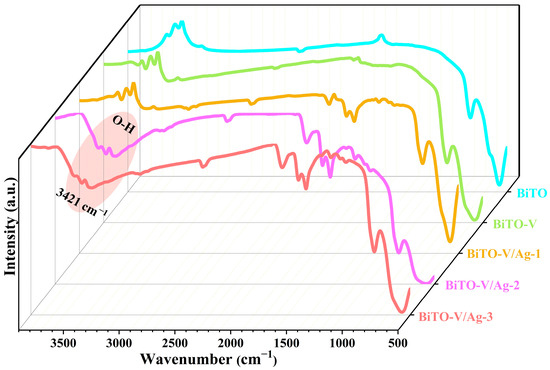
Figure 1.
FTIR spectra of the photocatalysts.
The crystal structure of the samples was analyzed using XRD. As shown in Figure 2, the diffraction peaks clearly correspond to the orthogonal structure of Bi4Ti3O12 (JCPDS No. 73-2181, a = b = 5.41 nm, c = 1.38 nm). The samples exhibited well-defined crystal structures, with no impurity phases, such as bismuth oxide or other oxides, detected. Notably, the diffraction peak at the (117) crystal plane was significantly enhanced after the formation of oxygen vacancies. This enhancement may be due to the lamellar structure of the original BTO, which has lower interlaminar binding energy along the c-axis [30,41]. As a result, the sample tends to stack and grow perpendicular to the c-axis, with the exposed primary crystal plane being (006). However, the introduction of oxygen vacancies alters the orientation of the BTO-V crystal, causing the BTO-V planes to contract and expose more active crystal planes. Furthermore, no corresponding diffraction peak from Ag NPs was observed in the BTO-V/Ag Schottky heterojunction. This absence may be attributed to the small particle size of Ag NPs and the strong diffraction intensity of BTO. Furthermore, the thickness of the fabricated composite catalyst, as calculated by the Scherrer formula (Table S1 and Equation (S1)), closely aligns with the findings obtained from the FE-SEM analysis. The thickness of BTO-V nanosheets is approximately 30 nm.
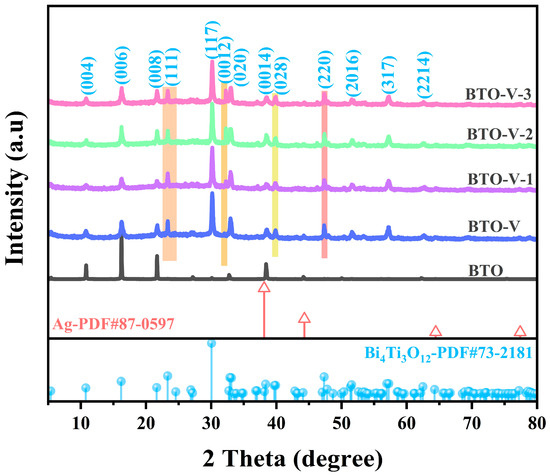
Figure 2.
XRD patterns of the photocatalysts.
The FE-SEM images reveal that BTO is a thin sheet with a thickness of approximately 50 nm, a length of 1.7 μm, and a width of 1.2 μm. In contrast, BTO-V exhibits smaller dimensions (Figure 3a,b). This nanosheet structure not only offers a large specific surface area, but also shortens the transfer and separation paths for piezoelectric and photoexcited carriers [42,43]. As the Ag NP content increases, a higher amount of Ag NPs is observed in the BTO-V/Ag samples (Figure 3c–f). However, excessive Ag NP loading in BTO-V/Ag-3 causes a complete coating of the BTO-V surface, which impairs both photoabsorption and piezoelectric effects, leading to reduced catalytic performance. The EDS maps of BTO-V/Ag-2 show a uniform distribution of Ag NPs.
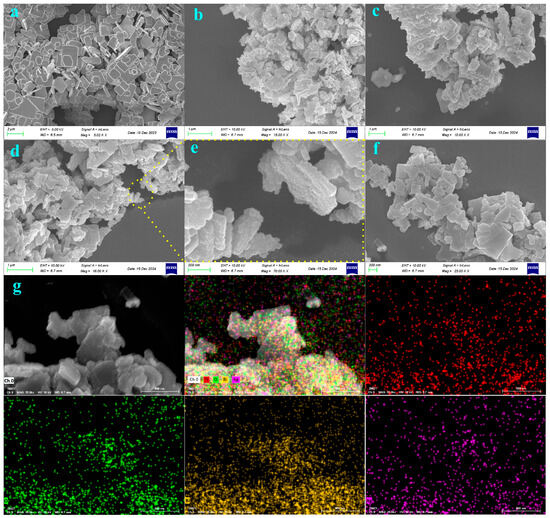
Figure 3.
FE-SEM images of the (a) BTO, (b) BTO-V, (c) BTO-V/Ag-1, (d,e) BTO-V/Ag-2, and (f) BTO-V/Ag-3. (g) The corresponding EDS maps of BTO-V/Ag-2.
2.2. Photogenerated Charge Separation and Piezo-Photocatalytic Synergy Properties
The optical properties of the prepared materials were characterized using the UV-vis DRS method. As shown in Figure 4a, the absorption edges of BTO and BTO-V occur around 410 nm. However, the introduction of oxygen vacancies causes a significant redshift at the lower absorption edge of the BTO-V curve [37,44]. The incorporation of Ag NPs into BTO-V leads to a widening of the absorption edge to 445 nm in the BTO-V/Ag-2 composite with a Schottky junction. The corresponding linearity of the Tauc plots ((αhv)2 ~ hv) confirms the optical bandgap of BTO, BTO-V, and BTO-V/Ag-2, respectively (Figure 3b, Equation (S2)). From the intercept of the tangent to hv, the bandgap (Eg) of BTO, BTO-V, and BTO-V/Ag-2 was estimated to be 2.87, 2.84, and 2.52 eV, respectively [27,44]. These results indicate that the composite catalyst exhibits a strong response to visible light. To further investigate the photocatalytic properties of the samples, steady-state photoluminescence (PL) was measured under 375 nm excitation. As shown in the PL image of Figure 4c, BTO-V/Ag-2 displays the minimum absorption intensity. This result clearly demonstrates that the recombination rate of electrons and holes in BTO-V/Ag-2 is the minimum among the samples investigated. Typically, such a low recombination rate implies that BTO-V/Ag-2 has an outstanding photoelectric separation efficiency, thereby conferring upon it the optimal photocatalytic performance. Moreover, oxygen vacancies are formed as a result of the consumption of lattice oxygen in BTO. This consumption occurs due to a reaction with ammonia gas, which is generated by the thermal decomposition of urea. To directly confirm the presence of oxygen vacancies, an electron paramagnetic resonance (EPR) analysis was conducted. As shown in Figure 4d, the BTO-V/Ag-2 sample exhibits a clear EPR signal at g = 2.001, which is commonly recognized as a signature of electrons trapped in oxygen vacancies [30,45,46].
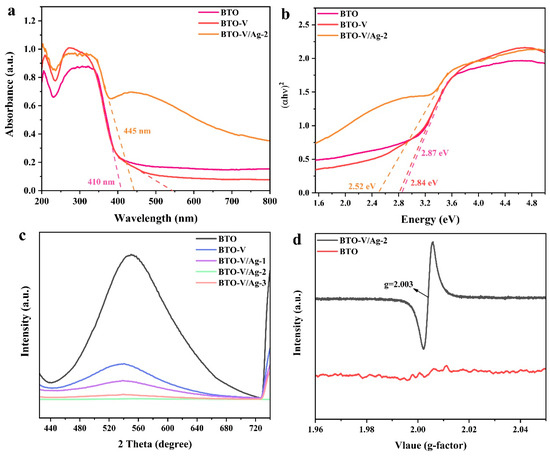
Figure 4.
(a) UV-vis DRS spectra and (b) corresponding Tauc plot. (c) Steady-state PL spectra with 375 nm light excitation. (d) EPR spectra of BTO and BTO-V/Ag-2.
The arc radius of BTO-V/Ag-2 was significantly reduced in electrochemical impedance spectroscopy (EIS) (Figure 5a). The results indicate that the ion and electron transfer resistances are low, demonstrating that the sample exhibits good electron transfer performance. Carrier dynamics were analyzed using a photoelectrochemical method. After the construction of Schottky structures, both BTO-V/Ag samples exhibited improved transient photocurrent responses (Figure 5b), suggesting that the photocarrier separation effect of the composite was significantly enhanced compared to that of BTO and BTO-V monomers. Furthermore, we evaluated the electrochemical properties of the samples under various conditions to assess the synergistic effects of piezoelectricity and light. BTO-V/Ag-2 was found to have optimal electron transport capacity, as determined by linear sweep voltammetry (LSV) (Figure 5c,d). Moreover, BTO-V/Ag-2 exhibited the highest current density under the synergistic mechanism of piezo-photocatalysis, further confirming the effectiveness of piezo-photocatalysis in enhancing charge separation and transport. This cooperative mechanism facilitates the generation of more effective photogenerated electrons and holes, which promote the production of various active species [47,48].
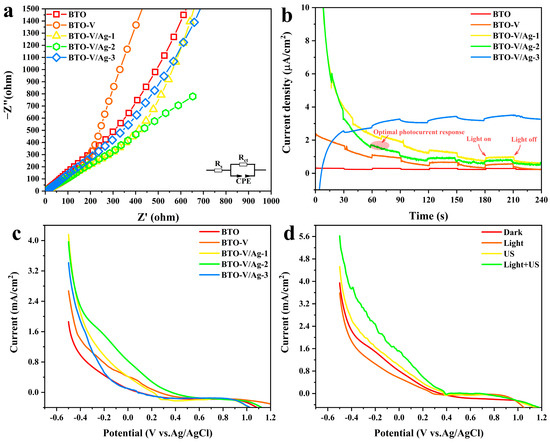
Figure 5.
(a) EIS curves, (b) transient photocurrent responses curves, and (c) LSV curves. (d) LSV curves were measured under dark, light, ultrasound (US), and coupling (light + US) conditions.
2.3. Piezo-Photocatalytic Activity of BTO-V/Ag Schottky Heterojunction
To evaluate the catalytic performance of the BTO-V/Ag Schottky heterojunction, a continuous flow reactor was employed to degrade pollutants. In this setup, the catalyst is pre-loaded into the reactor, and the attached plastic tube is sealed with a semi-permeable membrane to prevent catalyst loss. The performance of the composite catalyst was assessed using the method outlined in Section 3.3 to evaluate the catalytic degradation of NZT under conditions simulating combined visible light and ultrasonic piezoelectric excitation. As shown in Figure 6a–e, the characteristic absorption peaks of NZTD at 310 nm decreased significantly within 100, 100, 80, 70, and 90 min, respectively. Compared to BTO and BTO-V, the composite catalysts exhibited more complete degradation of NZTD. Additionally, the apparent reduction rate constant (kapp) was fitted using pseudo-first-order chemical kinetics. The catalysts can be ranked according to the reaction rate constants from highest to lowest: BTO-V/Ag-2 > BTO-V/Ag-1 > BTO-V/Ag-3 > BTO-V > BTO (as shown in Figure 7a–e), which is consistent with the optical performance analysis. Among them, BTO-V/Ag-2, exhibiting the best catalytic performance, degraded 98.34% (Equation (2)) of NZTD via piezoelectric photocatalysis in 70 min. Its reaction rate constant was 4.62 × 10−2 (Equation (1)), 4.32 times higher than that of the original BTO nanoplates. Moreover, when compared with the catalysts reported in the published literature (Table S2), this composite catalyst exhibits outstanding performance. This is attributed to the moderate and uniform load of Ag NPs, which establish good contact with BTO-V, forming a well-defined Schottky interface that facilitates rapid electron transfer. This promotes the directional separation of photogenerated carriers, thereby enhancing the performance of the composite catalyst. As shown in Figure 6f, pollutant degradation is limited when only ultrasonic excitation is applied. However, BTO, a classical piezoelectric material, generates piezoelectric potential under ultrasonic stimulation, which, in turn, creates an internal electric field. This enables it to function as a nanogenerator, providing continuous power for electron separation at the Schottky heterojunction interface. Therefore, the reaction rate can be significantly increased (7.35 × 10−2) through the synergistic effect of piezo-photocatalysis. The corresponding rate constant is much higher than that achieved with combined light and ultrasonic excitation alone [49]. The results indicate that the BTO-V/Ag-2 Schottky heterojunction exhibits a strong synergistic piezo-photocatalytic effect. Notably, the catalyst‘s activity is highly sensitive to fluctuations in the solution‘s pH. As shown in Figure 7f, the piezo-photocatalytic degradation performance of BTO-V/Ag-2 for NZTD significantly improves as the initial pH of the solution decreases. When the solution‘s pH = 2, the reaction rate reached 10.92 × 10−2, which was 2.36 times higher than that of the control group (pH = 7), and NZTD degradation was nearly complete. This is likely due to the protonation of NZTD under acidic conditions, which not only promotes its adsorption on the BTO-V/Ag-2 surface, but also reduces the nitro group on the NZTD molecule. The resulting increase in electron cloud density near the α-diimide and thiazole groups facilitates the attack of reactive oxygen species. Additionally, free H+ in the solution can combine with surface-bound hydrate-OH on BTO-V/Ag-2 to form a positively charged -OH2+ structure. Consequently, the electrostatic effect enhances H+ accumulation on the surface, effectively reduces the recombination of e- and h+, and generates the strong oxidation of •OH [39,50,51].
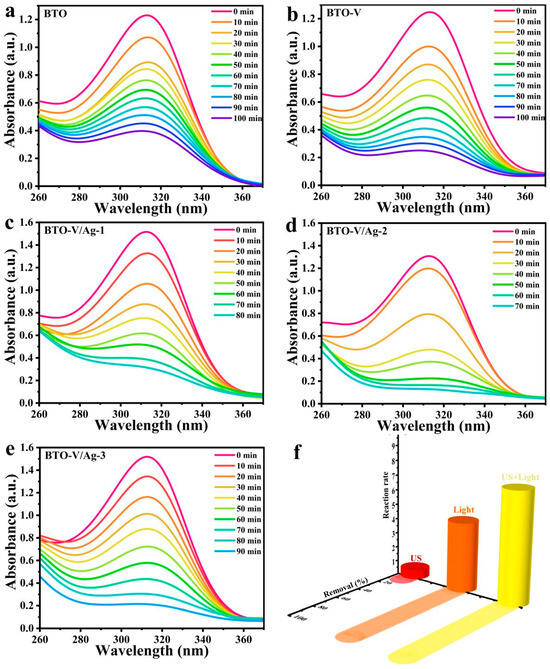
Figure 6.
(a–e) Time-varying UV–Vis spectrum for the eliminate reaction of NZTD under the catalysis of BTO, BTO-V, BTO-V/Ag-1, BTO-V/Ag-2, and BTO-V/Ag-3, respectively (the annotation at time 0 corresponds to 20 min of dark adsorption). (f) BTO-V/Ag-2 catalytic performance of NZTD removal under different excitation conditions.

Figure 7.
(a–e) Plot of ln(C0/Ct) against t for the catalytic process of NZTD with BTO, BTO-V, BTO-V/Ag-1, BTO-V/Ag-2, and BTO-V/Ag-3, respectively. (f) Effects of pH of solution on removal of NZT (with HCl and KOH).
In addition, the piezo-photocatalytic reaction demonstrates a strong temperature-dependent response (Figure 8a). The catalytic reaction rate increased with rising reaction temperature. However, Ag-NP-supported composite catalysts exhibited significant photothermal effects [52], with the surface temperature reaching approximately 43 °C after only 120 s of illumination (Figure 8c–g). This might be attributed to the circumstance that, during the photothermal conversion process, the LSPR effect of Ag NPs will persist in supplying energy in the form of a hot spot, thereby complementing the enthalpy alteration that occurs during the generation of active species [52,53,54]. The photothermal conversion efficiency of BTO-V/Ag can be further enhanced by incorporating a light source during piezo-photocatalysis. To assess the broad-spectrum catalytic performance of the composite catalyst (Figure 8b), we studied the catalytic degradation of classical cationic dyes (RB), anionic dyes (MB), and antibiotics (TC). The results showed that the degradation rates of RB, MB, and TC were 1.86, 3.35, and 9.81 × 10−2 min−1, respectively, indicating that BTO-V/Ag-2 effectively degrades various dyes and antibiotics with diverse chemical structures, demonstrating its broad potential for practical applications.
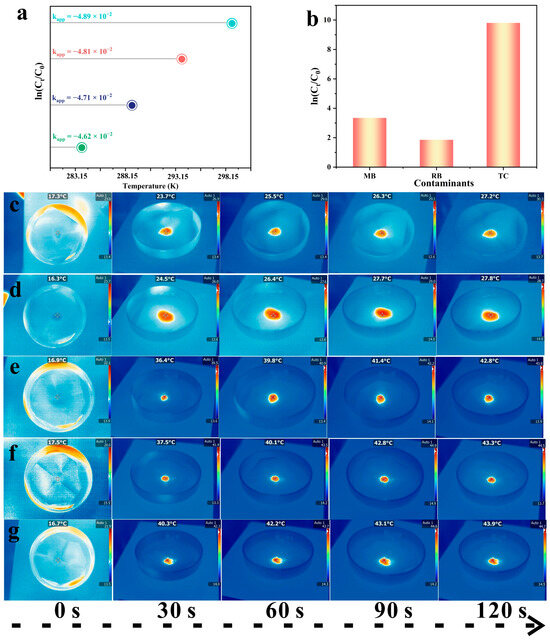
Figure 8.
(a,b) Reaction rate plot of BTO-V/Ag-2-catalyzed degradation performance at different temperatures and contaminants. (c–g) Infrared thermal images of BTO-V/Ag-2 at different time resolutions (0, 30, 60, 90, and 120 s).
TOC experiments were conducted to assess the ability of BTO-V/Ag piezo-photocatalysts to degrade NZTD. As shown in Figure 9a, under consistent reaction conditions, NZTD was nearly completely mineralized into carbon dioxide and inorganic salts after 180 min of reaction. Furthermore, the close association between Ag NPs and BTO-V contributed to the composite catalyst‘s excellent cyclic stability and maintained high catalytic activity after six cycles of piezoelectric photocatalysis, with a 95% pollutant removal rate (Figure 9b). FE-SEM images revealed that the surface of BTO-V/Ag-2 showed no significant damage before or after catalysis (Figure 9c–e). Therefore, the composite catalyst exhibits good reusability.
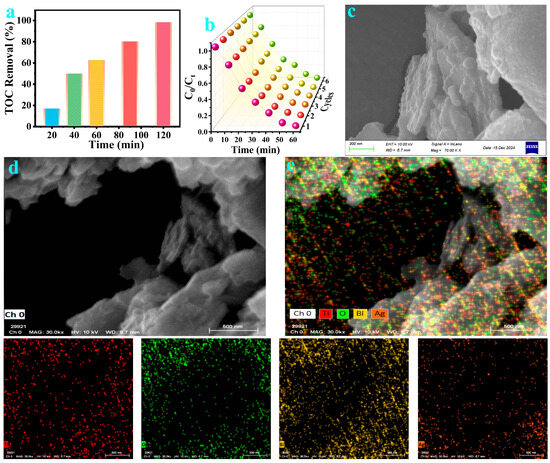
Figure 9.
(a) TOC removal efficiencies of NZTD; (b) catalytic degradation removal rate curve of BTO-V/Ag-2 catalyst. (c) FE-SEM topography of BTO-V/Ag-2 after six cycles of catalysis and (d,e) corresponding EDS maps.
Through the ultraviolet photoemission spectroscopy instrument (UPS) test presented in Figure 10, the work function values of BTO-V and Ag NPs are determined to be 4.73 V and 4.81 V (vs. normal hydrogen electrode (NHE)), respectively. Consequently, when Ag, which has a relatively large work function, comes into contact with the n-type semiconductor BTO-V, free electrons transfer from BTO-V to Ag. This transfer occurs to achieve the equilibrium of the Fermi levels (EF) between the two materials [27,28]. This results in the formation of an electron accumulation layer near the Ag side and an electron depletion layer near the BTO-V side. Consequently, the energy bands of BTO-V bend, eventually forming a Schottky barrier with an internal electric field structure. The direction of the built-in electric field is from the semiconductor towards the metal. When photogenerated carriers are generated, the built-in electric field effectively separates the electrons and holes. The photogenerated electrons move toward the conduction band of the semiconductor, while the holes move in the opposite direction. This reduces the recombination rate of electrons and holes, enabling a greater number of photogenerated carriers to participate in the catalytic reaction. Furthermore, piezoelectricity can induce the further bending of the energy bands, leading to the generation of more powerful reactive oxygen species (ROS) [55]. Oxygen vacancies regulate the band gap structure of BTO-V by acting as electron traps, facilitating carrier separation. The final composite catalyst can degrade organic pollutants into water, carbon dioxide, and some inorganic salts under piezoelectric photocatalysis.
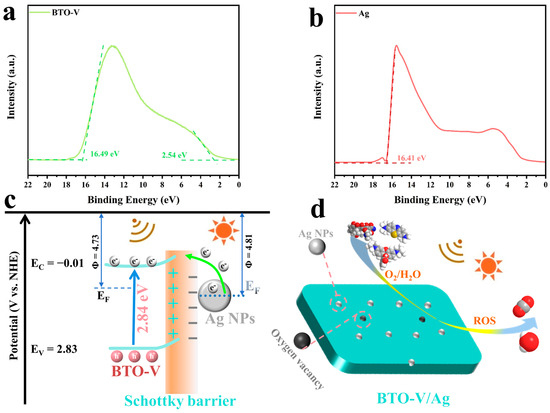
Figure 10.
UPS spectra of (a) BTO-V, (b) Ag, (c) Schottky barrier, and (d) piezo-photocatalysis mechanism.
3. Materials and Methods
3.1. Catalyst Preparation
BTO nanosheets with oxygen vacancies were synthesized using an optimized molten salt method. First, NaCl (3.65 g) and KCl (4.66 g) were used as flux and thoroughly ground in an agate mortar for 15 min. Next, Bi2O3 (2.33 g), TiO2 (0.6 g), and urea (0.6 g) were precisely added to the mixture and ground for 1.5 h until the mixture was smooth. The mixture was then transferred to a quartz crucible and calcined at 710 °C for 2 h in air, with a heating rate of 5 °C/min. The final product was washed alternately three times with deionized water and ethanol, then dried overnight at 50 °C, and named BTO-V. Additionally, pure BTO nanoplates were obtained by omitting urea.
A 0.2 g sample of BTO-V was uniformly dispersed in 40 mL of deionized water using 1 g of PVP. Silver nitrate (0.017, 0.051, and 0.17 g) was then added and stirred in the dark for 1 h, followed by heating at 75 °C for 7 h. The final product was washed alternately three times with deionized water and ethanol, then dried overnight at 50 °C. The final products were labeled BTO-V/Ag-1, BTO-V/Ag-2, and BTO-V/Ag-3 based on the silver nitrate content. All the reagents were purchased from Macklin Reagent Inc., Shanghai, China.
3.2. Characterization
Fourier transformed infrared (FT-IR) spectra were analyzed using KBr pellets with a Thermo Scientific (Madison, WI, USA) Nicolet IS10 spectrometer. The crystalline phases of samples were acquired using a Bruker (Billerica, MA, USA) D8 Advance Xray diffractometer (XRD, Cu-Kα radiation, λ = 1.541 Å). The energy levels of catalysts were analyzed by the UPS, Thermo Fisher Scientific ESCALAB 250Xi using the He I excitation source with the energy of 21.22 eV. The surface morphology of the catalysts were examined by field emission scanning electron microscope (FE-SEM) from Carl Zeiss (Oberkochen, Germany) Supra 55 at an accelerating voltage of 2 kV. The microscope was equipped with an energy-dispersive X-ray spectrometer (EDS). The degradation of the pollutant was measured by an AOE (Shanghai, China) UV-1800PC UV-visible spectrophotometer. Total organic carbon (TOC) was determined by a TOC analyzer (TOC-V, Shimadzu Co., Kyoto, Japan). The UV-vis diffuse reflectance spectrometer (DRS) spectra of catalysts were recorded by an ultraviolet-visible near-infrared spectrophotometer (UV-vis, Cary 7000, Agilent, Santa Clara, CA, USA) equipped with an integrating sphere to record the diffuse reflectance spectra, and BaSO4 was used as a reference. Steady-state and time-resolved photoluminescence (PL and TRPL) spectra were measured by a photoluminescence detector (Edinburgh instrument FLS980, Livingston, UK) with an excitation wavelength of 375 nm. Oxygen vacancies were confirmed by electron paramagnetic resonance (EPR), which was carried out on a Bruker EMX plus model spectrometer operating at the X-band frequency. A 300 W xenon lamp (PLS-SXE300E, Perfectlight Technology, Beijing, China, 400–780 nm) was adopted as the light source. Meanwhile, an ultrasonic disperser (LS-1200B) was employed for the purpose of acquiring ultrasonic irradiation. The electrochemical workstation of a homemade standard three-electrode battery (CHI 760E, Shanghai Chenhua Instrument Co., Ltd., Shanghai, China) was used to test some of the electrochemical properties of the catalyst.
3.3. Piezo-Photocatalytic Performance Assays
First, the 1 mg composite catalyst and NZT solution (25 mL, 30 mg/L) were mixed in a double-decker beaker and stirred in the dark for 10 min to achieve an adsorption-desorption equilibrium. Subsequently, the catalytic reaction was initiated at the light source and the ultrasound. Finally, the concentration of NZT was analyzed using a UV-vis spectrometer at 310 nm. Additionally, broad-spectrum degradation tests were conducted using 1 mg of composite catalysts with 40 mL of methylene blue (MB) (7.5 mg/L), rhodamine B (RB) (10 mg/L), and tetracycline (TC) (30 mg/L), respectively, following the aforementioned methods. To obtain stable data, the catalytic reaction was consistently conducted using circulating water at 10 °C to maintain a constant reaction temperature. All catalytic reactions were conducted at least three times. The cycle experiments were carried out using a similar procedure, and a peristaltic pump was employed to drive the feed solution back into the feed tank. To minimize catalyst loss, a semi-permeable membrane was installed at the front end of the drain tube.
The apparent reaction rate constant k was fitted from the pseudo-first-order kinetics rate Equation (1), as below.
The removal percentage (Per) was obtained from Equation (2) as below:
where C0 and Ct represent the contaminant concentrations of the system original and at time t.
3.4. Electrochemical Tests
The electrochemical tests, including transient photocurrent response (IT), electrochemical impedance spectra (EIS), linear sweep voltammetry (LSV), and Mott–Schottky electric potential, were conducted using an electrochemical workstation (CHI 760E, Shanghai Chenhua Instrument Co., Ltd., Shanghai, China) in a typical three-electrode system. In summary, 10 mg of the catalyst was initially dispersed in a mixture containing 0.6 mL of deionized water, 0.4 mL of ethanol, and 20 μL of a 5% Nafion solution. After 1 h of sonication, 50 μL of the mixture was uniformly applied to carbon paper (smear area: 0.5 × 0.5 cm2) and dried at 60 °C for 12 h to obtain the working electrode. The Ag/AgCl electrode served as the reference electrode, while the Pt filament electrode functioned as the counter electrode. A 0.5 M sodium sulfate solution was utilized as the electrolyte. Unless otherwise specified, all electrochemical tests were conducted in a stable dark environment.
4. Conclusions
A novel piezoelectric photocatalytic Schottky heterojunction was synthesized by introducing oxygen vacancies and the in situ depositing of Ag NPs onto BTO nanosheets. This resulted in the optimal interaction between BTO-V and the 2D/3D structure of Ag NPs. The successful loading of Ag NPs not only promotes the rapid separation of piezoelectric and photocatalytic charges, but also enhances light absorption through the LSPR effect. This enhancement improves photothermal conversion, which further promotes the generation of active species and accelerates catalytic reactions. Additionally, the surface concentration of -OH groups on BTO-V/Ag is significantly increased, improving the composite catalyst‘s acidic activation response. The results show that BTO-V/Ag efficiently facilitates piezoelectric photocatalytic degradation, removing 98.34% of NZTD and ultimately converting it into carbon dioxide and water. Although the interaction mechanism between the piezoelectric effect and the photocatalytic effect at the molecular level is not fully understood, this work provides some new insights into the rational design of high-performance piezoelectric-based photocatalysts and provides a reference for exploring the research of Schottky junction piezoelectric photocatalysts in large-scale industrial production.
Supplementary Materials
The following supporting information can be downloaded at: https://www.mdpi.com/article/10.3390/catal15020117/s1, Table S1: The mean crystallite size of samples were calculated with the Scherrer formula using the FWHM of the strong and sharp diffraction peak; Table S2: An exhaustive study of the catalytic activity of some catalysts for NZTD degradation. References [6,8,56,57] are cited in the Supplementary Materials.
Author Contributions
S.L.: Writing—original draft, Investigation, Formal analysis, Conceptualization, Visualization, Writing—review and editing. C.H.: Conceptualization. Y.G. (Ying Gong): Methodology. Y.G. (Yujuan Guo): Investigation, Data curation. Z.C.: Methodology. M.Y.: Formal analysis. Z.L.: Investigation. X.X.: Formal analysis. Z.X.: Visualization. J.D.: Data curation. P.S.: Visualization. Q.L.: Writing—review and editing, Conceptualization. All authors have read and agreed to the published version of the manuscript.
Funding
This work was supported by Guangxi Science and Technology Major Program (Grant Nos. AA2420602, AA24206037).
Data Availability Statement
The data presented in this study are available in the article.
Conflicts of Interest
The authors declare no conflicts of interest.
References
- Imgharn, A.; Sun, T.; Nicolle, J.; Naciri, Y.; Hsini, A.; Albourine, A.; Ania, C. A simple approach to prepare a C3N4/MoO3 heterojunction with improved photocatalytic performance for the degradation of methylparaben. Catalysts 2024, 14, 170. [Google Scholar] [CrossRef]
- Reincke, M.; Arlt, W.; Damdimopoulou, P.; Köhrle, J.; Bertherat, J. Endocrine disrupting chemicals are a threat to hormone health: A commentary on behalf of the ESE. Nat. Rev. Endocrinol. 2024, 20, 187–188. [Google Scholar] [CrossRef] [PubMed]
- Stevens, S.; Bartosova, Z.; Völker, J.; Wagner, M. Migration of endocrine and metabolism disrupting chemicals from plastic food packaging. Environ. Int. 2024, 189, 108791. [Google Scholar] [CrossRef] [PubMed]
- Devendrapandi, G.; Liu, X.; Balu, R.; Ayyamperumal, R.; Arasu, M.V.; Lavanya, M.; Reddy, V.R.M.; Kim, W.K.; Karthika, P. Innovative remediation strategies for persistent organic pollutants in soil and water: A comprehensive review. Environ. Res. 2024, 249, 118404. [Google Scholar] [CrossRef]
- Yan, X.; Xia, Y.; Ti, C.; Shan, J.; Wu, Y.; Yan, X. Thirty years of experience in water pollution control in Taihu Lake: A review. Sci. Total Environ. 2024, 914, 169821. [Google Scholar] [CrossRef] [PubMed]
- Zhao, Y.; Zhang, Y.; Cao, X.; Li, J.; Hou, X. Synthesis of MOF on MOF photocatalysts using PCN-134 as seed through epitaxial growth strategy towards nizatidine degradation. Chem. Eng. J. 2023, 465, 143000. [Google Scholar] [CrossRef]
- Zhang, J.; Liu, Y.; Zhang, Z. Nanoconfined catalytic water purification within CoFeCu LDH-assembled membrane nanochannels. Appl. Catal. B Environ. Energy 2024, 357, 124290. [Google Scholar] [CrossRef]
- Zhou, Y.; Fu, J.; Zeng, Z.; Gao, Y.; Zhang, Z.; Han, B.; Ma, J.; Jiang, J. Oxidation of amine-based pharmaceuticals with unactivated peroxymonosulfate: Kinetics, mechanisms, and elimination efficiency of NDMA formation. J. Hazard. Mater. 2024, 463, 132961. [Google Scholar] [CrossRef]
- You, S.C.; Seo, S.I.; Falconer, T.; Yanover, C.; Duarte-Salles, T.; Seager, S.; Posada, J.D.; Shah, N.H.; Nguyen, P.-A.; Kim, Y. Ranitidine use and incident cancer in a multinational cohort. JAMA Netw. Open 2023, 6, e2333495. [Google Scholar] [CrossRef]
- Madhav, S.; Ahamad, A.; Singh, A.K.; Kushawaha, J.; Chauhan, J.S.; Sharma, S.; Singh, P. Water pollutants: Sources and impact on the environment and human health. Sens. Water Pollut. Monit. Role Mater. 2020, 12, 43–62. [Google Scholar]
- Saravanan, A.; Kumar, P.S.; Vo, D.-V.N.; Jeevanantham, S.; Karishma, S.; Yaashikaa, P. A review on catalytic-enzyme degradation of toxic environmental pollutants: Microbial enzymes. J. Hazard. Mater. 2021, 419, 126451. [Google Scholar] [CrossRef] [PubMed]
- Wu, J.-C.; Chuang, Y.-H.; Liou, S.Y.H.; Li, Q.; Hou, C.-H. In situ engineering of highly conductive TiO2/carbon heterostructure fibers for enhanced electrocatalytic degradation of water pollutants. J. Hazard. Mater. 2022, 429, 128328. [Google Scholar] [CrossRef]
- Fu, Z.-J.; Jiang, S.-K.; Chao, X.-Y.; Zhang, C.-X.; Shi, Q.; Wang, Z.-Y.; Liu, M.-L.; Sun, S.-P. Removing miscellaneous heavy metals by all-in-one ion exchange-nanofiltration membrane. Water Res. 2022, 222, 118888. [Google Scholar] [CrossRef]
- Du, C.; Zhang, Y.; Zhang, Z.; Zhou, L.; Yu, G.; Wen, X.; Chi, T.; Wang, G.; Su, Y.; Deng, F. Fe-based metal organic frameworks (Fe-MOFs) for organic pollutants removal via photo-Fenton: A review. Chem. Eng. J. 2022, 431, 133932. [Google Scholar] [CrossRef]
- Weng, Z.; Lin, Y.; Han, B.; Zhang, X.; Guo, Q.; Luo, Y.; Ou, X.; Zhou, Y.; Jiang, J. Donor-acceptor engineered g-C3N4 enabling peroxymonosulfate photocatalytic conversion to 1O2 with nearly 100% selectivity. J. Hazard. Mater. 2023, 448, 130869. [Google Scholar] [CrossRef] [PubMed]
- Soufi, A.; Hajjaoui, H.; Elmoubarki, R.; Abdennouri, M.; Qourzal, S.; Barka, N. Spinel ferrites nanoparticles: Synthesis methods and application in heterogeneous Fenton oxidation of organic pollutants–A review. Appl. Surface Sci. Adv. 2021, 6, 100145. [Google Scholar] [CrossRef]
- Bai, Z.; Xie, Y.; Wei, X.; Zhou, L.; Bao, J.; Tang, R.; Wen, Y.; Zhao, Z.; Deng, J.; Zhao, Z. Intrinsic metal ion dual-regulated fabrication of multifunctional nano-interfacial BiFeVO4/Fe-MOF for high photo-Fenton-like synergistic catalytic oxytetracycline removal. Appl. Catal. B Environ. Energy 2025, 361, 124634. [Google Scholar] [CrossRef]
- Chee, S.S.; Seo, D.; Kim, H.; Jang, H.; Lee, S.; Moon, S.P.; Lee, K.H.; Kim, S.W.; Choi, H.; Ham, M.H. Lowering the Schottky barrier height by graphene/Ag electrodes for high-mobility MoS2 field-effect transistors. Adv. Mater. 2019, 31, 1804422. [Google Scholar] [CrossRef]
- Nguyen, P.H.; Pham, M.-T.; Nguyen, H.Q.; Cao, T.M.; Van Pham, V. Boosting visible-light-driven photocatalysis of nitrogen oxide degradation by Mott–Schottky Pd/TiO2 heterojunctions. Sep. Purif. Technol. 2025, 354, 129012. [Google Scholar] [CrossRef]
- Jia, P.; Han, Z.; Chen, J.; Liu, J.; Wang, L.; Zhang, X.; Guo, Y.; Zhou, J. Pt@WS2 Mott–Schottky heterojunction boosts light-driven active ion transport for enhanced ionic power harvesting. ACS Nano 2024, 31, 233–239. [Google Scholar] [CrossRef]
- Mendoza-Sánchez, A.R.; Hernandez-Rodríguez, Y.; Casas-Espínola, J.; Cigarroa-Mayorga, O. Nanostructural modulation of Schottky barrier in Au/α-MoO3 heterojunction via Au nanoparticle size control. Appl. Surface Sci. 2024, 670, 160624. [Google Scholar] [CrossRef]
- Li, G.; Wu, S.; Liu, J.; Wang, K.; Chen, X.; Liu, H. Narrow bandgap schottky heterojunction sonosensitizer with high electron–hole separation boosted sonodynamic therapy in bladder cancer. Adv. Mater. 2024, 36, 2401252. [Google Scholar] [CrossRef] [PubMed]
- Ghodselahi, T.; Neishaboorynejad, T.; Arsalani, S. Fabrication LSPR sensor chip of Ag NPs and their biosensor application based on interparticle coupling. Appl. Surface Sci. 2015, 343, 194–201. [Google Scholar] [CrossRef]
- Lu, X.; Ma, Z.; Chang, Y.; Wang, S.; Li, X.; Xu, D.; Bao, J.; Liu, Y. Mott-Schottky construction boosted plasmon thermal and electronic effects on the Ag/CoV-LDH nanohybrids for highly-efficient water oxidation. Adv. Mater. 2024, 26, 2313057. [Google Scholar] [CrossRef]
- Wen, Y.; Che, H.; Tang, C.; Liu, B.; Ao, Y. A Schottky heterojunction with spatially separated active sites for piezo-photocatalytic dual-channel hydrogen peroxide generation. Nano Energy 2024, 128, 109837. [Google Scholar] [CrossRef]
- Jia, P.; Li, J.; Huang, H. Piezocatalysts and piezo-photocatalysts: From material design to diverse applications. Adv. Funct. Mater. 2024, 34, 2407309. [Google Scholar] [CrossRef]
- Chen, L.; Ren, J.T.; Yuan, Z.Y. Enabling internal electric fields to enhance energy and environmental catalysis. Adv. Energy Mater. 2023, 13, 2203720. [Google Scholar] [CrossRef]
- Zhao, X.; Liu, M.; Wang, Y.; Xiong, Y.; Yang, P.; Qin, J.; Xiong, X.; Lei, Y. Designing a built-in electric field for efficient energy electrocatalysis. ACS Nano 2022, 16, 19959–19979. [Google Scholar] [CrossRef]
- Zheng, H.; Wang, Y.; Liu, J.; Yan, K.; Zhu, K. Recent advancements in the use of novel piezoelectric materials for piezocatalytic and piezo-photocatalytic applications. Appl. Catal. B Environ. Energy 2024, 341, 123335. [Google Scholar] [CrossRef]
- Tang, Q.; Wu, J.; Chen, X.-Z.; Sanchis-Gual, R.; Veciana, A.; Franco, C.; Kim, D.; Surin, I.; Pérez-Ramírez, J.; Mattera, M. Tuning oxygen vacancies in Bi4Ti3O12 nanosheets to boost piezo-photocatalytic activity. Nano Energy 2023, 108, 108202. [Google Scholar] [CrossRef]
- Geng, Y.; Zhang, X.; Wang, F. Investigation of the physical characteristics of Bi4Ti3O12, Bi2Ti4O11, Bi12TiO20, Bi2Ti2O7 ternary semiconductors. Mat. Sci. Semicon. Proc. 2024, 181, 108658. [Google Scholar] [CrossRef]
- Chauhan, A.; Kumar, R.; Raizada, P.; Khan, A.A.P.; Ahamad, T.; Van Le, Q.; Nguyen, V.-H.; Thakur, S.; Singh, P.; Sudhaik, A. Advances in bismuth titanate (Bi12TiO20)-based photocatalysts for environmental remediation: Fundamentals and practical applications. J. Water Proc. Eng. 2024, 59, 104974. [Google Scholar] [CrossRef]
- Man, R.; Dan, Y.; Fan, J.; Wang, C.; Li, Z.; Zhou, T.; Lu, X.; Zhao, M. Enhanced piezoelectricity in Al2O3 (0001) single crystal substrate sintered Bi12TiO20-BaTiO3 composite ceramics. New J. Chem. 2024, 12, 33–39. [Google Scholar] [CrossRef]
- Nesa Soheli, S.; Lu, Z.; Sun, D.; Shyha, I. Lead-free NaNbO3-based ceramics for electrostatic energy storage capacitors. Ceramics 2024, 7, 712–734. [Google Scholar] [CrossRef]
- Gumiel, C.; Colado, M.; Calatayud, D.G.; Barea, R.; Villegas, M.; Jardiel, T. Microstructure modulation of a Bi4Ti3O12 thin film system by combining the effect of a simple processing methodology with a co-doping strategy involving Nd3+ and Nb5+. Boletín Soc. Española Cerámica Vidr. 2024, 63, 425–433. [Google Scholar] [CrossRef]
- Murthy, R.K.; Shivanna, M.; Ahamed, N.N.; Bhoomika, V.; Ravikumar, C.; Murthy, H.A. Photocatalytic and electrochemical sensor study of combustion synthesized bismuth oxide (Bi2O3) nanoparticles using lemon and urea fuels. Mater. Sci. Eng. B 2024, 307, 117487. [Google Scholar] [CrossRef]
- Wang, C.; Chen, F.; Hu, C.; Ma, T.; Zhang, Y.; Huang, H. Efficient piezocatalytic H2O2 production of atomic-level thickness Bi4Ti3O12 nanosheets with surface oxygen vacancy. Chem. Eng. J. 2022, 431, 133930. [Google Scholar] [CrossRef]
- Tang, Q.; Wu, J.; Kim, D.; Franco, C.; Terzopoulou, A.; Veciana, A.; Puigmartí-Luis, J.; Chen, X.Z.; Nelson, B.J.; Pané, S. Enhanced piezocatalytic performance of BaTiO3 nanosheets with highly exposed {001} facets. Adv. Funct. Mater. 2022, 32, 2202180. [Google Scholar] [CrossRef]
- Liu, S.; Guo, Y.; Yi, S.; Yan, S.; Ouyang, C.; Deng, F.; Li, C.; Liao, G.; Li, Q. Facile synthesis of pure silicon zeolite-confined silver nanoparticles and their catalytic activity for the reduction of 4-nitrophenol and methylene blue. Sep. Purif. Technol. 2023, 307, 122727. [Google Scholar] [CrossRef]
- Hu, X.; Li, K.; Wu, X.; Wang, N.; Li, X.; Li, Q.; Li, L.; Lv, K. Dramatic promotion of visible-light photoreactivity of TiO2 hollow microspheres towards NO oxidation by introduction of oxygen vacancy. Appl. Catal. B Environ. Energy 2019, 256, 117860. [Google Scholar] [CrossRef]
- Liu, X.; Zhou, Z.; Lu, Y.; Wang, T.; Huo, P.; Yan, Y. Increasing visible-light absorption for photocatalysis with black 2D Bi4Ti3O12 nanosheets. Adv. Powder Technol. 2019, 30, 1043–1050. [Google Scholar] [CrossRef]
- Yang, L.; Tian, B.; Xie, Y.; Dong, S.; Yang, M.; Gai, S.; Lin, J. Oxygen-vacancy-rich piezoelectric BiO2−x nanosheets for augmented piezocatalytic, sonothermal, and enzymatic therapies. Adv. Mater. 2023, 35, 2300648. [Google Scholar] [CrossRef] [PubMed]
- Khorasani, M.; Soleimani-Javid, Z.; Arshid, E.; Amir, S.; Civalek, Ö. Vibration analysis of graphene nanoplatelets’ reinforced composite plates integrated by piezo-electromagnetic patches on the piezo-electromagnetic media. Wave. Random Complex Media 2024, 34, 2394–2424. [Google Scholar] [CrossRef]
- Zhang, J.; Zhang, Y.; Li, L.; Yan, W.; Wang, H.; Mao, W.; Cui, Y.; Li, Y.; Zhu, X. Synergizing the internal electric field and ferroelectric polarization of the BiFeO3/ZnIn2S4 Z-scheme heterojunction for photocatalytic overall water splitting. J. Mater. Chem. A 2023, 11, 434–446. [Google Scholar] [CrossRef]
- Kang, X.; Dong, G.; Dong, T. Oxygen vacancy defect engineering of heterophase junction TiO2: Interfacial/surface oxygen vacancies coadjust the photocatalytic ROS production. ACS Appl. Energy Mater. 2022, 6, 1025–1036. [Google Scholar] [CrossRef]
- Xie, Y.; Ding, K.; Liu, Z.; Tao, R.; Sun, Z.; Zhang, H.; An, G. In situ controllable loading of ultrafine noble metal particles on titania. J. Am. Chem. Soc. 2009, 131, 6648–6649. [Google Scholar] [CrossRef]
- Ding, J.; Guo, D.; Wang, N.; Wang, H.F.; Yang, X.; Shen, K.; Chen, L.; Li, Y. Defect engineered metal–organic framework with accelerated structural transformation for efficient oxygen evolution reaction. Angew. Chem. Int. Edit. 2023, 62, e202311909. [Google Scholar] [CrossRef]
- Meng, L.; Zhao, C.; Zhang, X.; Guo, R.; Zheng, Y.; Chu, H.; Fu, H.; Wang, P.; Wang, C.-C. Piezo-photocatalytic synergetic for H2O2 generation via dual-pathway over Z-scheme ZIF-L/g-C3N4 heterojunction. Nano Energy 2024, 128, 109795. [Google Scholar] [CrossRef]
- Wu, C.; Wang, A.C.; Ding, W.; Guo, H.; Wang, Z.L. Triboelectric nanogenerator: A foundation of the energy for the new era. Adv. Energy Mater. 2019, 9, 1802906. [Google Scholar] [CrossRef]
- Cui, W.-G.; Gao, F.; Na, G.; Wang, X.; Li, Z.; Yang, Y.; Niu, Z.; Qu, Y.; Wang, D.; Pan, H. Insights into the pH effect on hydrogen electrocatalysis. Chem. Soc. Rev. 2024, 53, 10253–10311. [Google Scholar] [CrossRef]
- Alkaim, A.; Aljeboree, A.; Alrazaq, N.; Baqir, S.; Hussein, F.; Lilo, A. Effect of pH on adsorption and photocatalytic degradation efficiency of different catalysts on removal of methylene blue. Asian J. Chem. 2014, 26, 8445. [Google Scholar] [CrossRef]
- Liu, S.; Deng, F.; Guo, Y.; Ouyang, C.; Yi, S.; Li, C.; Liao, G.; Li, Q. Silver nanocatalysts supported by multiple melanin carriers with a photothermal effect for reduction of methylene blue and 4-nitrophenol. ACS Appl. Nano Mater. 2023, 7, 889–903. [Google Scholar] [CrossRef]
- Chen, J.; Ning, C.; Zhou, Z.; Yu, P.; Zhu, Y.; Tan, G.; Mao, C. Nanomaterials as photothermal therapeutic agents. Prog. Mater. Sci. 2019, 99, 1–26. [Google Scholar]
- Ouyang, C.; Liu, S.; Guo, Y.; Yi, S.; Li, Q. Silver nanoparticles decorated polydopamine-coated pure silica zeolite as an efficient nanocatalyst for organic pollutants removal. Appl. Surface Sci. 2024, 652, 159281. [Google Scholar] [CrossRef]
- Wu, C.; Zhang, X.; Sun, Q.; Hou, X.; Wang, T. Enhanced photocatalytic degradation of sulfathiazole via dual-ligand Zr-MOFs: A porphyrin and pyrene-based energy transfer. Sep. Purif. Technol. 2025, 354, 128727. [Google Scholar]
- Hattali, O.A.; Marzouqi, F.; Al Mamari, S.; Kuvarega, A.T.; Selvaraj, R. CdO nanoplates for photocatalytic degradation of Levofloxacin and Nizatidine under natural solar light irradiation. Inorg. Chem. Commun. 2022, 146, 110071. [Google Scholar]
- Zhao, Y.; Cao, X.; Zhang, Y.; Li, J.; Chen, P.; Hou, X. Novel edge-epitaxial MOF on MOF for efficient nizatidine removal. J. Taiwan Inst. Chem. Eng. 2024, 163, 105643. [Google Scholar] [CrossRef]
Disclaimer/Publisher’s Note: The statements, opinions and data contained in all publications are solely those of the individual author(s) and contributor(s) and not of MDPI and/or the editor(s). MDPI and/or the editor(s) disclaim responsibility for any injury to people or property resulting from any ideas, methods, instructions or products referred to in the content. |
© 2025 by the authors. Licensee MDPI, Basel, Switzerland. This article is an open access article distributed under the terms and conditions of the Creative Commons Attribution (CC BY) license (https://creativecommons.org/licenses/by/4.0/).